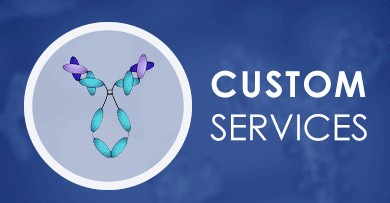 Loading...
Loading...

CBL
 Loading...
Loading...Anti-CBL Products
-
- Type: Rabbit IgG
- Application: WB
-
- Species Reactivity: Human, Rat
- Type: Rabbit IgG
- Application: WB, IP
-
- Species Reactivity: Human
- Type: Rabbit IgG
- Application: WB, ICC, IF, IP
- Mouse Anti-CBL Recombinant Antibody (VS3-CJ789) (VS3-CJ789)
-
- Species Reactivity: Human
- Type: Mouse IgG2b, κ
- Application: WB
-
- Derivation: Mouse
- Species Reactivity: Human, Mouse, Rat
- Type: Mouse IgG1
- Application: WB, IHC, ICC, FC, ELISA
- Human Anti-CBL Recombinant Antibody (clone CLB-1) (FAMAB-0287-CN)
-
- Derivation: Phage display library
- Type: Human IgG
- Application: ELISA
- Mouse Anti-CBL Recombinant Antibody (clone 5D1) (FAMAB-0273-CN)
-
- Type: Mouse IgG
- Application: WB, ELISA
- Mouse Anti-CBL Recombinant Antibody (clone CBLNC-104) (FAMAB-0161-CN)
-
- Type: Mouse IgG
- Application: WB, ELISA
- Mouse Anti-CBL Recombinant Antibody (clone 3B12) (MOB-0344CT)
-
- Species Reactivity: Human
- Type: Mouse IgG1
- Application: ELISA, WB
- Mouse Anti-CBL Recombinant Antibody (clone 34A6) (MOB-2089z)
-
- Derivation: Mouse
- Species Reactivity: Human
- Type: Mouse IgG
- Application: WB, ELISA, ICC, IF, IHC
- Human Anti-CBL Recombinant Antibody (clone CLB-1); scFv Fragment (FAMAB-0287-CN-S(P))
-
- Derivation: Phage display library
- Type: Human scFv
- Application: ELISA
- Mouse Anti-CBL Recombinant Antibody (clone 5D1); scFv Fragment (FAMAB-0273-CN-S(P))
-
- Type: Mouse scFv
- Application: WB, ELISA
- Mouse Anti-CBL Recombinant Antibody (clone CBLNC-104); scFv Fragment (FAMAB-0161-CN-S(P))
-
- Type: Mouse scFv
- Application: WB, ELISA
- Human Anti-CBL Recombinant Antibody (clone CLB-1); Fab Fragment (FAMAB-0287-CN-F(E))
-
- Derivation: Phage display library
- Type: Human Fab
- Application: ELISA
- Mouse Anti-CBL Recombinant Antibody (clone 5D1); Fab Fragment (FAMAB-0273-CN-F(E))
-
- Type: Mouse Fab
- Application: WB, ELISA
- Mouse Anti-CBL Recombinant Antibody (clone CBLNC-104); Fab Fragment (FAMAB-0161-CN-F(E))
-
- Type: Mouse Fab
- Application: WB, ELISA
- Rabbit Anti-NHP CBL Recombinant Antibody (VS-1024-XY67) (VS-1024-XY67)
-
- Species Reactivity: Human, Non-human primate
- Type: Rabbit IgG
- Application: WB, IP
- Anti-Human CBL Immunohistochemistry Kit (VS-0525-XY1031)
-
- Species Reactivity: Human
- Target: CBL
- Application: IHC
- Anti-CBL Immunohistochemistry Kit (VS-0325-XY322)
-
- Species Reactivity: Human, Mouse
- Target: CBL
- Application: IHC
-
- Derivation: Phage display library screening
- Species Reactivity: Human
- Type: Rabbit IgG
- Application: FC, IF, WB
-
- Derivation: Mouse
- Species Reactivity: Human, Mouse, Rat
- Type: Mouse IgG
- Application: WB, IHC-p, IF, ICC, FCM, ELISA
Can't find the products you're looking for? Try to filter in the left sidebar.Filter By Tag
Our customer service representatives are available 24 hours a day, from Monday to Sunday. Contact Us
For Research Use Only. Not For Clinical Use.
Background
Cancer-related genes, Disease related genes, Enzymes, Human disease related genes, Metabolic proteins, Potential drug targets
Intracellular
Low cell type specificity
Immune cell enhanced (neutrophil)
Low cell line specificity
Forms homodimers; IFT20 promotes the formation of stable homodimers (PubMed:29237719). Interacts (phosphorylated at Tyr-731) with PIK3R1. Associates with NCK via its SH3 domain. The phosphorylated C-terminus interacts with CD2AP via its second SH3 domain. Binds to UBE2L3. Interacts with adapters SLA, SLA2 and with the phosphorylated C-terminus of SH2B2. Interacts with EGFR, SYK and ZAP70 via the highly conserved Cbl-N region. Also interacts with SORBS1 and INPPL1/SHIP2. Interacts with phosphorylated LAT2 (By similarity). Interacts with CBLB (PubMed:29237719). Interacts with ALK, AXL, BLK, FGR and FGFR2. Interacts with CSF1R, EPHB1, FLT1, KDR, PDGFRA and PDGFRB; regulates receptor degradation through ubiquitination. Interacts with HCK and LYN. Interacts with ATX2 (By similarity). Interacts with TEK/TIE2 (tyrosine phosphorylated). Interacts with SH3KBP1 and this interaction is inhibited in the presence of SHKBP1 (By similarity). Interacts with SIGLEC10 (By similarity). Interacts with IFT20 (PubMed:29237719). Interacts with SPRY2; the interaction inhibits CBL-mediated ubiquitination of EGFR (PubMed:17974561). (Microbial infection) Interacts with M.tuberculosis LpqN, which influences the balance between intrinsic antibacterial and antiviral defense.
Transferase



